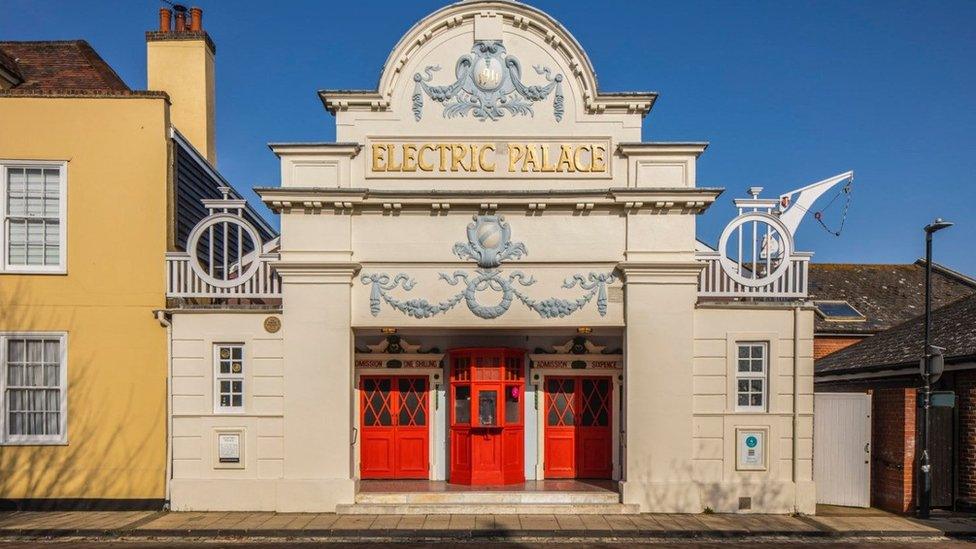Harwich Electric Palace: How one of the first cinemas was saved from ruin
- Published

When the Electric Palace was built in 1911, cinemas were more of an event than a place to watch films
Tucked away on a backstreet in the Essex coastal town of Harwich lies one the nation's oldest cinemas. It has survived two world wars, the threat of demolition and the Covid pandemic. Now, after a two-year restoration project, it is poised once again to open its doors.
When the Electric Palace was built in 1911, cinemas were more of an event than a place to watch films.
A travelling showman would arrive in town, set up a projector and avid audiences would enjoy whatever was beamed onto a makeshift screen.
It could be a dangerous business. The nitrate film stock of the time was highly unstable and caused several serious fires.
"In the early days of film, most people had never seen moving pictures," said David Looser, chairman of the Harwich Electric Palace Trust.
"It was mostly travelling people, sometimes from fairgrounds, who would have a projector and a roll of film and put it up in a theatre or village hall."
The Electric Palace was built in 1911 by the travelling showman Charles Thurston
In 1909, the Cinematograph Act was introduced to try to ensure that all screenings took place in buildings which were safe and suitable for public showings.
Two years later, the Electric Palace was created by the travelling showman Charles Thurston.
Thurston built two other cinemas - the Empire Cinema in Biggleswade, Bedfordshire, and the Palace Cinema in Norwich, Norfolk.
The first film shown at the Electric Palace was The Battle of Trafalgar and the Death of Nelson. Admittance was 2d for a wooden bench seat, rising to 6d for a seat in the middle of the auditorium or a shilling (worth about ┬Ż6.20 in today's money) for a plush perch at the back of the cinema.
The Electric Palace was created by the travelling showman Charles Thurston
By the 1950s, the Electric Palace's fortunes were in decline.
In 1956, it shut its doors and lay derelict for the next 16 years.
It escaped demolition in 1972 following efforts to list it as a "building of sociological interest", and was reopened in 1981 by the Harwich Electric Palace Trust.
The Grade II* listed venue has been on the Heritage at Risk Register since 2019
In 2019, the Grade II* listed venue was placed on the Heritage at Risk Register.
Structural defects were found, along with a water leak which had caused serious damage to the floor.
Since then, it has been given more than ┬Ż1.5 million of grant funding.
You might also be interested in:
While the pandemic forced other cinemas to close during lockdowns, the Electric Palace was already shut while refurbishment works were carried out.
The work included replacing the roof, removing asbestos, repairing the original ornate fibrous plaster ceiling, redecorating the interior, replacing part of the auditorium floor and refurbishing the auditorium seating.
That work has now been completed and the cinema has kept original features such as its ornamental front entrance, its projection room and the original screen.
David Cleveland and Nigel Lister, technical and archivist volunteers at the Electric Palace Cinema, Harwich
Mr Looser told how the discovery of asbestos in 2019 caused havoc.
"This discovery brought work to an abrupt halt and left us with a building in a highly vulnerable state," he said.
"At this point Historic England came to our rescue.
"They placed the Electric Palace on the Heritage at Risk Register and quickly approved a grant to clear the asbestos, with additional funding support from The National Lottery Heritage Fund."
Without the funding, he said, the cinema might have closed forever.
The work programme included replacing the roof to make the building safe
Mr Looser said he was "delighted" that the repair and restoration project was complete and that the trust could reopen the cinema.
He said the cinema will reopen on April 8 and then "celebrate more prominently at a later date".
Trudi Hughes, heritage at risk surveyor at Historic England, who oversaw the progress of the repair and restoration work, said: "The Electric Palace Cinema is a fascinating and very special survival.
"It has escaped demolition, was saved by the Harwich Society and passed to the Harwich Electric Palace Trust by Tendring District Council.
"With this last phase of work now complete, the auditorium is at its absolute best, retaining much of its original charm and unique character.
"I can't wait to see the cinema buzzing with visitors and sharing the magic of film, in this unique setting, as it has done for over a hundred years."
Find │╔╚╦┬█╠│ News: East of England on , and . If you have a story suggestion email eastofenglandnews@bbc.co.uk
- Published12 March 2022
- Published23 October 2021
- Published23 June 2019